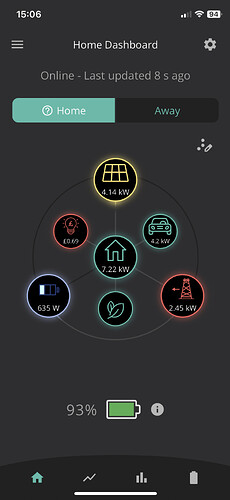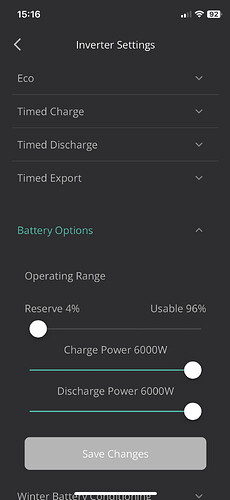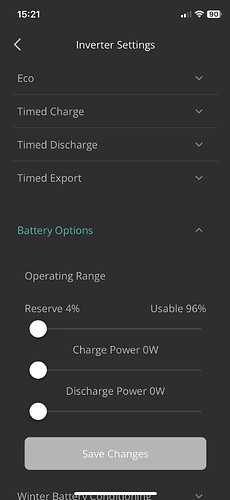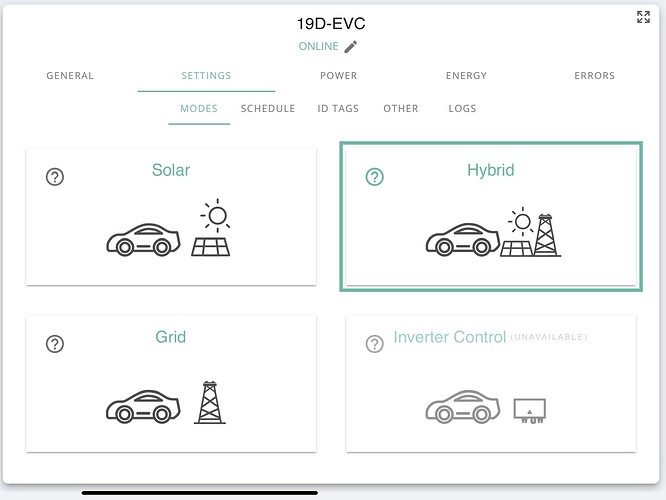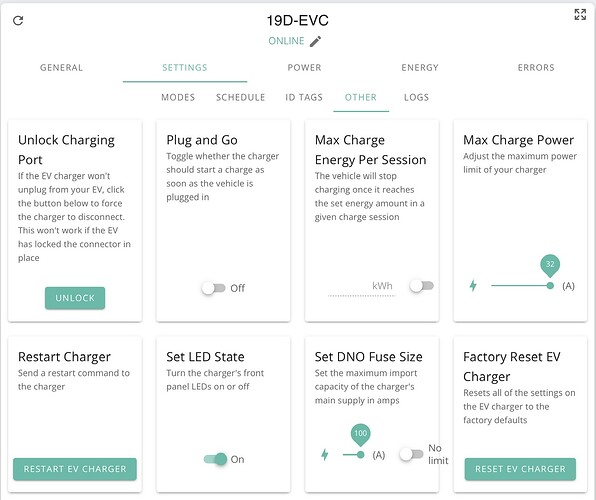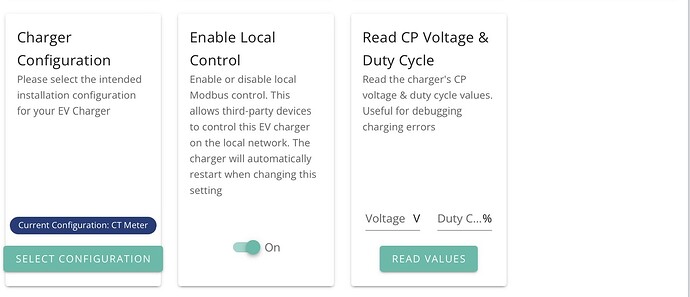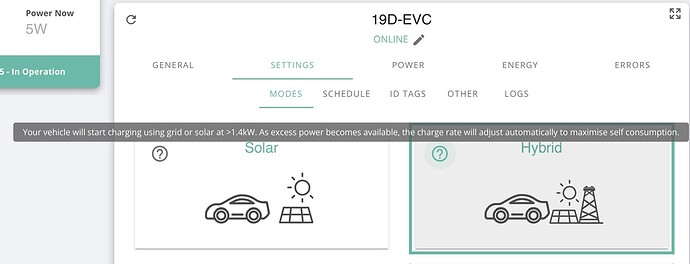Looking at the app, I can see that the solar generation is charging the EV when excess is being generated. However the house load is being pulled from the grid instead of the AIO supplying the house load….? It seems that if you set the system to charge the car when excess is being generated it stops the AIO from taking up the house load?
I looked at the battery settings and they had reset themselves to 0 for charge and discharge, changed them back to 6kw and the battery now takes up the house load while still charging the car via solar…it was fine until the solar generation was over xxkw and started charging the car but it seems it also sets the battery charge/discharge to zero…..! Bug???
Ok so something is resetting the battery charge/discharge to zero as a few secs later the battery settings have changed to zero again! Help?
Hi yah, there are a number of things going on that the settings will do differently to what you may want/thinking about.
The ideal situation would be to say, house load is solar 1st then battery, then grid.
EV is Solar then grid.
Battery supply the house if needed, but not the EV.
If the above was manually being looked at every 60 sec by you, then it would work, however!
House load = everything in the house including the EV, so to stop your battery draining to the EV battery, the automation has parked your battery. What should now happen is the house load is from Solar. The next part is how much solar is going to the EV v your house load, the automation thinks it’s all house load, so all the solar is going to the EV and if there is extra needed for say the cooker then it has to come from the grid
Check the logs on the Website - see who/what is changing the charging values, in the past if you have signed up to the “Smart” tarrif and hand over control to Octopus etc.. they could be doing it.
Also - check you API keys in the security section as you might have something just taking control of your unit ( Home assistant etc… )
I noticed this as well, if you are using homeassistant I wrote a simple automation that checks the SOC is above 95% and the adjusts the charge current to reflect the amount of excess solar energy.
alias: Surplus Solar to EV Charger Only
description: ""
mode: single
triggers:
- hours: "*"
minutes: /5
seconds: "0"
trigger: time_pattern
conditions: []
actions:
- variables:
exportCurrent: "{{ ( (states('sensor.givtcp_xxxxxx_pv_power')|float) - \n\t(states('sensor.givtcp_xxxxxx_load_power')|float) - \n\t(states('sensor.givenergy_ev_power_watts')|float))/240 }}"
- if:
- condition: time
after: "09:00:00"
before: "16:00:00"
weekday:
- mon
- tue
- wed
- thu
- fri
- sat
- sun
- type: is_battery_level
condition: device
device_id: NNNNNNNNNNNNNNNNNNNNNNNN
entity_id: NNNNNNNNNNNNNNNNNNNNNNNN
domain: sensor
above: 95
then:
- if:
- condition: template
value_template: "{{ exportCurrent> 6 }}"
then:
- action: rest_command.givenergy_ev_adjust_charge_power_limit
data:
limit: "{{exportCurrent}}"
- action: rest_command.givenergy_ev_startcharge
metadata: {}
data: {}
else:
- action: rest_command.givenergy_ev_stopcharge
metadata: {}
data: {}
else:
- action: rest_command.givenergy_ev_adjust_charge_power_limit
data:
limit: 32
- action: rest_command.givenergy_ev_stopcharge
metadata: {}
data: {}
So….. no HomeKit at the property. The charge/discharge settings are being changed by the system when it is sending solar to the EV charger and changes back when it isn’t… we have no control over that at all..
I get that the system sees the house load (including the EV) so if it’s sending (e.g) 1.6Kw to the EVC and the PV is generating (e.g) 5Kw and the house is pulling 8Kw, the rest comes from the grid currently and not the AIO which is nigh on fully charged… clearly the system knows what it is sending to the EV so why can’t the AIO pick up the additional house load!!! It seems that the second the PV generates enough for trigger the EVC, it ignores the AIO in fact it effectively turns the AIO off and pulls the rest from the grid. That just has to be a bug. Like I said, I can reset the charge/discharge to 6Kw and it works for a short period then the system sets it back to zero until the PV output falls below 1.4Kw ish then it all goes back to normal. Simply put, it costs money that is unnecessary. I am not on an intelligent octopus tariff so no outside influence occurring.
Actually having looked at all the settings and what they actually do, when solar is charging the EV (priority solar to EV) the AIO sends a constant 630w to the grid regardless of how much the house is pulling while solar is charging the EV. e.g. solar generation 4Kw, EV taking 2Kw, house wants 7Kw, 1Kw is pulled from the grid and the AIO discharges 630w to the grid. The battery drain doesn’t change much (a couple of watts) regardless of the house load while solar is charging the EV. Sure I can set the AIO to allow discharge to the EV but I’ll wager it will do it all the time including at night……. The system clearly knows what the house load is and what the percentage is EV and house, please tell me it’s not that dumb to not support the house (not the EV) load as the whole charge via solar is actually costing me money when it should be free….. anyone at GivEnergy confirm it’s a bug or ‘that’s the way it works’ which would then need fixing…..please!!!
Just fyi, these are the settings I have set. I have done them in the GE Cloud Portal, as the app settings are not as good to see.
Out of interest, why have you selected ‘hybrid’ for the charging mode? With the good weather I’d want solar (as I have set) to charge the EV and not pull anything from the grid as the AIO is fully charged and ‘should’ pick up any additional house load over and above what the system is sending to the EV. System clearly knows all this so why do I have to pull from the grid when it is completely unnecessary? Honestly thought it was me but alas it is ‘by design’ and needs fixing…?
So I had just Solar for a while, but if I needed any grid(during a cheap slot) I had to do it manually or change it. As I am on Octopus Go I want it to change during the night and Solar if above 1.4 kW, so hybrid is the better option.
I kept getting loads of ground leak errors when in Inverter Control. I get less in hybrid but still get about 5 to 8 a day
